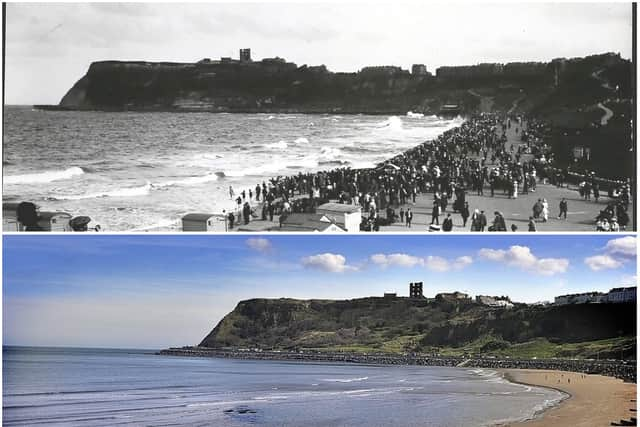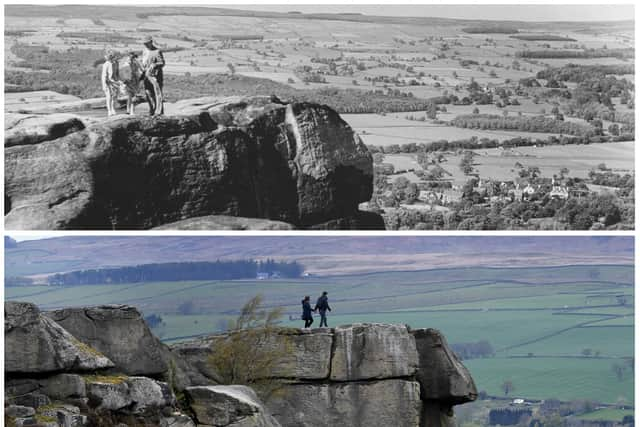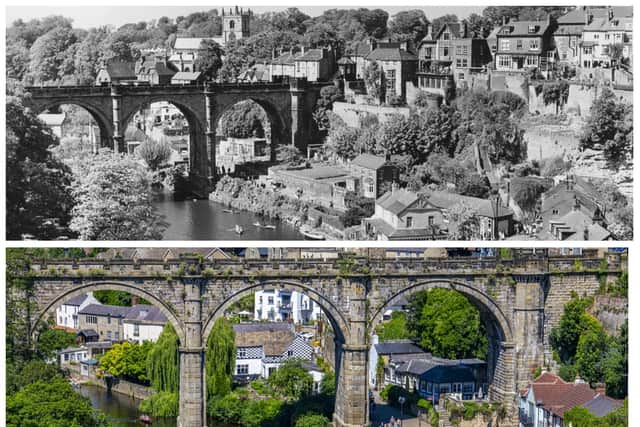Amazing photos show what the most popular Yorkshire towns looked like in the 20th century compared to now
The 19th century saw Yorkshire’s growth due to the increasing population and the Industrial Revolution continuing in coal, textile and steel, particularly in cities such as Sheffield, Rotherham and Middlesbrough. However, even though the industry was vastly improving in cities, living conditions began dwindling in industrial towns due to overcrowding. Cholera broke out in 1832 and 1848 negatively affecting residents in these towns.
But by the end of the 19th century and beginning of the 20th century, advances were made with the introduction of modern sewers and water supplies. Then came the popularity of spa towns Harrogate and Scarborough, which flourished due to people believing in the healthy benefits of mineral water.
Advertisement
Hide AdAdvertisement
Hide AdThese spa towns also drew in tourists and visitors from far and wide; Harrogate draws in numerous visitors because of its conference facilities and in 2016, these events alone attracted 300,000 people to the town. Harrogate is also popular for its Great Yorkshire Showground and Bettys and Taylors of Harrogate.
Harrogate
Loading....
Various attractions include its spa waters and RHS Harlow Carr gardens and its popularity has grown due to its close proximity to the Yorkshire Dales National Park and the Nidderdale AONB.
For two years running between 2013 and 2015, Harrogate was voted as the ‘happiest place to live’ in Britain.
Spa towns were established in the 16th century, the same era when Harrogate was founded. Harrogate spa water contains iron, sulphur and common salt and it became known as ‘The English Spa’ in the Georgian era, after its waters were discovered in the 1500s.
Advertisement
Hide AdAdvertisement
Hide AdThe Victoria Baths was built in 1871 with separate treatment rooms and bathing pools for men and women. This was followed by the Royal Baths [pictured in 1913 and 2020], which opened in 1897 and were designed to provide a luxury atmosphere for specialist hydrotherapy treatments.
Harrogate’s flourishing development is attributed to the discovery of its chalybeate- and sulphur-rich spring water from the 16th century; the first mineral spring was discovered in 1571 by William Slingsby who found out that water from the Tewit Well in High Harrogate possessed similar properties to that from springs in the Belgian town of Spa, which ‘spa towns’ were named after.
Water gas was created by engineering inventor, Samson Fox, who discovered this in the basement laboratory of Grove House. Following his discovery at his home on Skipton Road, his was the first house in Yorkshire to have gas lighting and heating, so he built a town-sized plant to supply to the entire town of Harrogate.
Sadly, Harrogate’s popularity declined following the First World War and during the Second World War, Harrogate’s large hotels accommodated government offices evacuated from London, paving the way for the town to become a flourishing commercial, conference and exhibition centre.
Advertisement
Hide AdAdvertisement
Hide AdIn recent years, the town was popular for other reasons; the convention centre was developed in 2020 to be used as a Nightingale Hospital during the Covid-19 pandemic which received high praise. Until now, the town brings in more than £150 million to the local economy every year and attracts in excess of 350,000 business visitors annually.
Harrogate is well served by restaurants, Parliament Street and Cheltenham Parade, which are both lined up with many independent and chain restaurants, making the town very popular for eating out.
Scarborough


The seaside resorts in Yorkshire are home to some of the best sandy beaches; Scarborough is Britain’s oldest seaside resort dating back to the spa town-era in the 17th century.
The town lies between 10 and 230ft above sea level, from the harbour rising steeply north and west towards limestone cliffs. It is the largest holiday resort on the Yorkshire Coast with a population of 61,905 and the largest seaside town in North Yorkshire.
Advertisement
Hide AdAdvertisement
Hide AdScarborough has fishing and service industries, as well as an increasing digital and creative economy and a huge tourist destination.
The town is thought to have been founded around 966 AD as Skaroaborg by Thorgils Skarthi, a Viking raider, though there is no archaeological evidence to support these claims.
However, there is evidence of much earlier Stone Age and Bronze Age settlements, though any new settlement was soon burned to the ground by a rival group of Vikings under Tostig Godwinson, Lord of Falsgrave and Harald III of Norway.
A Roman signal station was built on a cliff-top location overlooking the North Sea; it was built to warn off sea-raiders and coins found at the site show that it was occupied from 370 AD until the early fifth century.
Advertisement
Hide AdAdvertisement
Hide AdAn excavation was undertaken in 2021 that unveiled a Roman luxury villa, religious sanctuary, or combination of both, at a housing development in Eastfield. Historic England described the finds as ‘one of the most important Roman discoveries in the past decade’.
During the First World War the town was bombed by German warships of the High Seas Fleet, which shocked the British and the Scarborough Pier Lighthouse, built in 1806, was damaged in the attack.
There was an assault on a U-boat and on September 25, 1916, saw three people killed and a further five injured. 11 of Scarborough’s trawler fleet were sunk at sea in another U-boat attack on September 4, 1917.
Despite its adversities during the two Wars, Scarborough flourished again from the mid-20th century with many attractions drawing in tourists including the North Bay beach [pictured in 1913 and 2017], which was traditionally considered the more peaceful end of the resort and is home to Peasholm Park.
Advertisement
Hide AdAdvertisement
Hide AdWhitby
Loading....
Whitby has been voted the best beach in the UK. It is located on the east coast of Yorkshire at the mouth of River Esk and has a maritime, mineral and tourist heritage.
The fishing port was popularised during the Middle Ages, supporting important herring and whaling fleets, and was where Captain Cook learned seamanship and where his vessel, The Endeavour, was built. Tourism began in Whitby during the Georgian Era and developed due to the arrival of the railway in 1839.
The town was elevated as a tourist attraction by the proximity of the high ground of the North York Moors National Park and the heritage coastline and by association with the horror novel Dracula.
The earliest record of permanent existence of residents is in 656 AD when Streanæshealh was the place where Oswy, the Christian king of Northumbria, founded the first abbey, under the abbess Hilda.
Advertisement
Hide AdAdvertisement
Hide AdThe following centuries saw Whitby functioning as a fishing settlement until the 18th century when it developed as a port and centre for shipbuilding and whaling. Whitby flourished as a spa town in the Georgian times when, like Harrogate, three chalybeate springs were in demand for their healthy benefits and tonic qualities.
During the 20th century the fishing fleet kept the harbour busy and few cargo boats used the port. It was infused with new life following a strike at Hull docks in 1955, when six ships were diverted and unloaded their cargoes on the fish quay.
A marina was started in 1979 by dredging the upper harbour [pictured in 1972 and 2020] and laying pontoons.
Ilkley


Ilkley’s spa town heritage and surrounding countryside has made its tourist trade a crucial component of the local industry and the town centre is characterised by Victorian architecture, wide streets and floral displays.
Advertisement
Hide AdAdvertisement
Hide AdThe earliest evidence of settlement in the town is from flint arrowheads or microliths, dating to the Mesolithic period, from around 11,000 BC onwards. The area around Ilkley has been consistently settled since at least the Neolithic period, around 3,000 BC.
Since 1969, Ilkley has been twinned with Coutances, France
There are plenty of popular cycle races that pass through the town; the steep climb up to the Cow and Calf rocks [pictured in 1950 and 2021] at the edge of Ilkley Moor is usually the reason for the races to visit as it presents a short but challenging climb.
For three years in a row between 1994 and 1996, the climb was used as part of the Leeds Classic, which was part of the World Cup series of events and in 2005 and 2007, the town hosted stages of the Tour of Britain race.
The town was part of the biggest cycling moment in history in 2014, when the Tour de France passed through.
Advertisement
Hide AdAdvertisement
Hide AdKnaresborough


The River Nidd [pictured in 1960 and 2021] merges from the River Ouse and attracts around 150,000 visitors a year.
Knaresborough is mentioned in the Domesday Book of 1086 as Chenaresburg which means ‘Cenheard’s fortress’, then was renamed Claro Wapentake in the 12th century.
Knaresborough Castle is Norman; around 1100, the town began to grow and provided a market, attracting traders to service the castle.
The railway era started in 1848 in Knaresborough with the opening of a railway station on Hay Park Lane and was replaced with the current Knaresborough railway station three years later in 1851.
Knaresborough became part of North Yorkshire in 1974.
Comment Guidelines
National World encourages reader discussion on our stories. User feedback, insights and back-and-forth exchanges add a rich layer of context to reporting. Please review our Community Guidelines before commenting.
